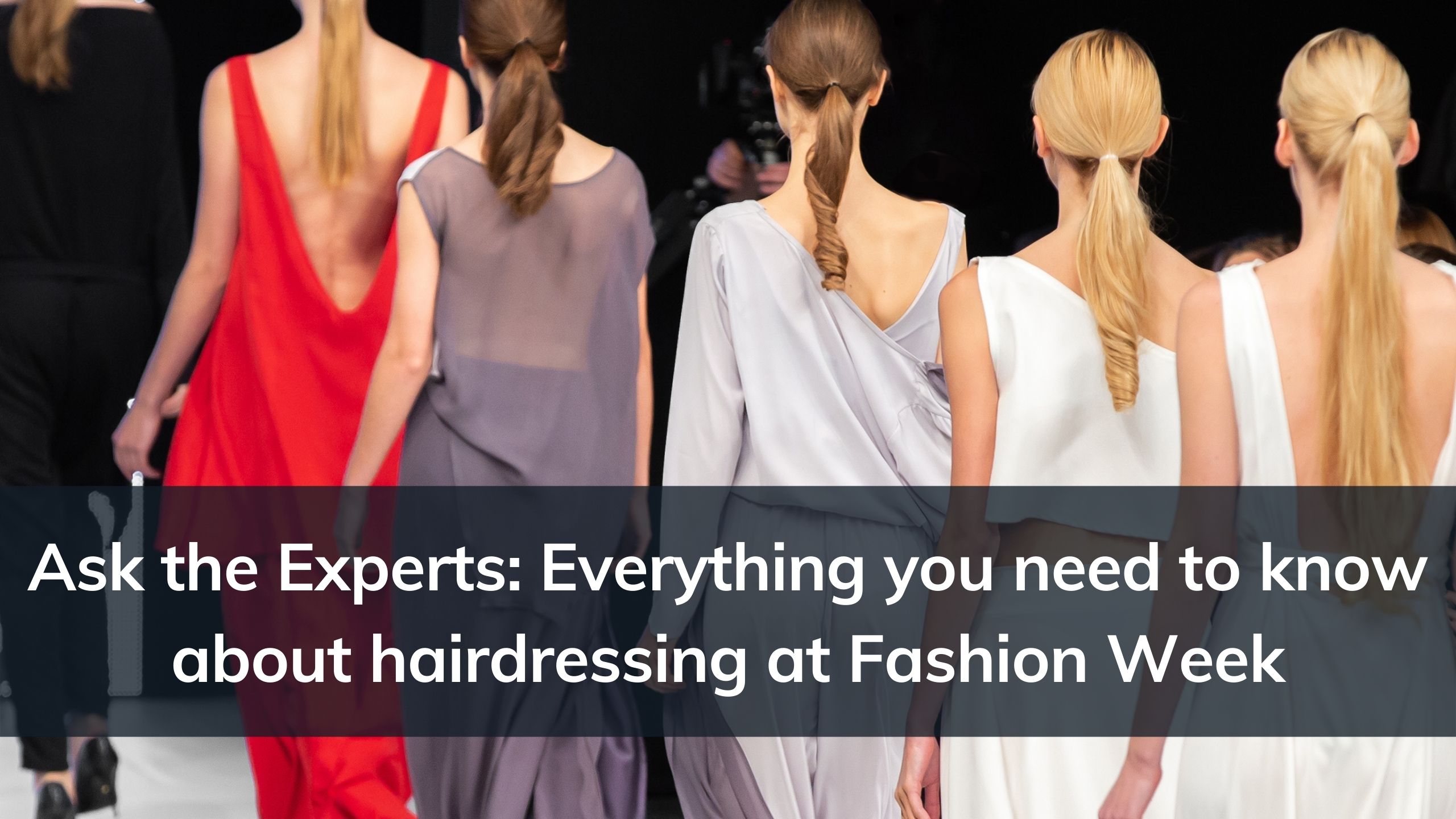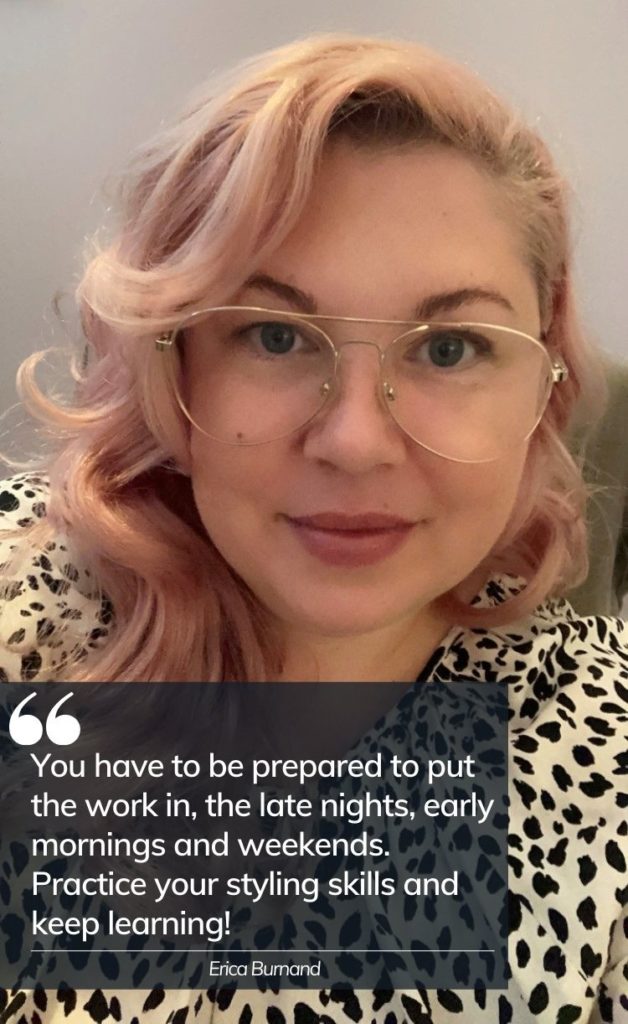With London Fashion Week 2021 upon us, we asked our hair experts to tell us what it’s like hairdressing behind the scenes on the runway. With decades of industry experience between them, they explain everything from translating the designers’ vision to the highs and lows of fashion hairdressing.

Ever wondered why the wet hair look was all the rage last year? Two words – Fashion Week. The weeks in the year when the industry’s top designers present their collections for the following seasons. Most major cities have their own Fashion Week (like New York Fashion Week and London Fashion Week). Of course, everyone knows that these events set the style trends for the year. But the unsung heroes of the most fashionable time of the year are the hairdressers that complete the designer’s vision and, in turn, set the hairdressing trends for the next season.
But what’s it really being backstage as a hairdresser? With London Fashion Week 2021 kicking off this week, we asked our hair experts, Erica Burnand and Kevin Day, to share their experiences of fashion and catwalk hairstyling. Between them, they have clocked up a collective 51 years in the hair industry. During this time, they have been behind the scenes at Edinburgh Graduate Fashion Week and London Fashion Week and have done hair for fashion industry giants like Maria Grachvogel, Antoni and Alison, Ben De Lisi and Debbie Wingham.
 How did you get into catwalk and fashion hairdressing?
How did you get into catwalk and fashion hairdressing?
Kevin: I was fortunate enough to do my hairdressing apprenticeship at John Frieda, which gave me access to these opportunities due to close links with the designers.
Erica: A local independent shop in Cheshire that provided high-end designer fashion hosted a new season fashion show. My passion and skills for styling and dressing hair meant that they asked me to create the hairstyles for their models.
Can you describe a typical day of hairdressing during fashion week?
Kevin: It’s manic. A lot is going on, so organisational skills are essential. There are usually a few shows a day, with models doing multiple shows. This means they can arrive late and often with the previous style and products still in the hair.
Erica: You start by setting up all of the tools, equipment, and necessary accessories, so you’re ready to adapt the theme to each model and outfit. All of the models must be ready to go at the same time, so you’re working as a team with the makeup team and designer to bring their vision to life quickly. Then it’s about making sure you get all your last-minute quick checks while the models are lined up and ready to walk, touching up their hair after outfit changes, all without getting in the way.
How do you translate a designer’s ideas into reality? What’s that process like for a hairdresser?
Kevin: There are a lot of meetings between the team leaders and the designers. The designer expresses their vision, and then it’s about experimenting and testing styles until we have the right look.
Erica: The head of the creative team will liaise with the designer. They will then bring the model headshots and style inspirations to the innovative team to discuss and plan a theme and hairstyles that will suit the designer’s needs. These ideas are then presented to the designer to select.
What are the best things about fashion week and catwalk hairdressing?
Kevin: The atmosphere is electric. There is always so much going on and to see your finished work walking down the catwalk is so rewarding.
Erica: The energy and excitement build throughout the preparation. Then the half-hour before the show starts, there’s an adrenaline rush whilst perfecting everything and juggling issues like trying to find the model that hasn’t turned up yet or is still with makeup when they should be in hair. Finally, watching the models walk, all finished, is a massive team effort. It makes you feel super proud!
What are the worst things about fashion week and catwalk hairdressing?
Kevin: It’s often not as glamorous as you think. Tensions run high as you are working to a tight schedule with often 30 models to style plus touch-ups in-between costume changes.
Erica: The missing models – but it wouldn’t be the same if they all turned up at the right time!
Do you have any advice for hairdressers wanting to get into events like London Fashion Week?
Kevin: There are often events at local colleges or boutiques you can get involved in while training to give you experience. At Alan D Hairdressing Education, we worked closely with Debbie Wingham for years. A team of learners were put together to work on her fashion shows linked to London Fashion Week, and the work appeared in big fashion magazines. These are experiences that cannot be bought and are essential for development.
What is often overlooked is the utilisation of foundation techniques used to style the hair, like perfecting a sleek ponytail and getting it to a level that produces an effective and striking image. Your foundation techniques are essential. They aren’t always exciting, but you definitely need to do the basics very well.
Erica: You have to be prepared to put the work in, the late nights, early mornings and weekends. Practice your styling skills and keep learning!
What would you have wanted to know before working behind the scenes during fashion week?
Kevin: Just how chaotic it is backstage and the level of organisation needed. These are essential skills you’ll need to use every day in the salon to ensure everything runs effectively. So the next time you think someone is on your back, have a little think about why they are pushing you. It is to prepare you for every aspect of the trade, not just technical abilities.
Erica: Eat before the prep session starts! It’s such a long, intense day. I once went without eating, and it was hard! You really need the fuel to sustain the adrenaline for such long periods.
